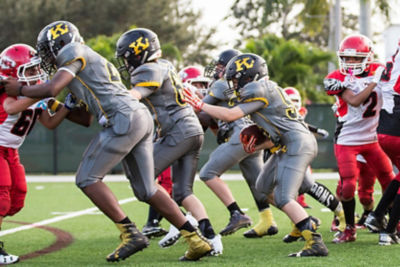Football 101: Football Formations
First year as a football family? Get to the first game knowing a little more than just the basics. Learn about football formations so you can sound more like an expert in the stands this season.

On offense, 11 players play eight positions; on defense, 11 players play seven positions. This creates hundreds of possible player combinations on both sides of the ball that can be used to develop plays that are run out of specific formations. Here we look at some basic formations on both sides of the ball.
FOOTBALL OFFENSIVE FORMATIONS
On every offensive play, the team deploys five linemen and a QB. This is the foundation of every play. Offensive coaches then vary the number of players at the Wide Receiver (WR), Running Back (RB), and Tight End (TE) positions. Here are a few of the basic formations and how they are changed from play to play.
I-Formation
This basic formation usually deploys two WRs, two RBs, and one TE. It gets its name from the two running backs lining up behind the quarterback, one behind the other, resembling an “I” dotted by the QB. The WRs are split out wide with one on the line of scrimmage and one off the line of scrimmage, and the TE is next to a tackle. The side with the TE is called the strong side with the opposite side being the weak side.
I-Formation Common Variations:
- Offset the running back (usually the fullback (FB)) closest to the QB to either the strong or weak side.
- Replace one of the WRs with a second TE on the offensive line.
Pro Set
The base Pro Set formation uses the same personnel as the I-Formation. The primary difference being how the running backs line up behind the QB. In the Pro Set, the RBs line up in a split backs formation, meaning one to each side of, and behind the QB.
Pro-Set Common Variations:
- Replace one of the WRs with a second TE on the offensive line.
Single-back
The single back, as its name implies, uses one Running Back positioned behind the QB. The running back can line up directly behind the QB or offset to either side. The role vacated by the second running back can now be deployed in several capacities making this a versatile and popular formation that usually uses between two and five WRs.
Single-Back Common Variations:
- Two WRs split wide with two TEs on each side of the line.
- Three WRs with one in “the slot” between the Tackle and the WR, and one TE.
- Four WRs and zero TEs.
- Five WRs, zero TEs and zero RBs, also known as the empty set or empty backfield.
- Bunch formations where receivers (WRs, TEs or Backs) are lined up in a bunch on either side of the line.
Shotgun Formation
The most notable feature of the Shotgun Formation is where the QB lines up. Rather than directly behind the center, the QB positions himself about five yards behind the line, thus requiring the Center to throw him the ball. The extra space gives the QB extra time to throw the ball and to give receivers additional time to run their routes. Any of the previous skill position packages can be deployed from the Shotgun Formation, but as it’s designed for passing, it usually makes use of more receivers.
FOOTBALL DEFENSIVE FORMATIONS
There are three basic levels to a defensive formation: the line, linebackers and the secondary. Variations to defensive formations come in the number and combinations of players at each of these levels. Traditionally, defensive formations are named according to the number of down linemen and linebackers. While defensive coaches often take liberties with personnel packages, here are basic defenses from which they often work.
3-4
The 3-4 defense is so named because it deploys three down linemen and four linebackers (LBs), hence the 3-4. This leaves four defensive backs in the secondary. The line is made up of two Defensive Ends (DE) flanking a Defensive Tackle, (DT) known as a Nose Tackle (NT). The contingent of LBs is made up of two Inside LBs (ILBs) who line up behind the middle of the line, and two Outside LBs (OLBs) who typically line up behind and to the side of the DEs. This defensive formation is traditionally topped off with two Corner Backs (CBs), a Strong Safety (SS) and a Free Safety (FS). The 3-4 four is designed to take advantage of the relative speed and playmaking abilities of its LBs. It is used against base offenses consisting one or two WRs, one or two RBs, and one or two TEs.
4-3
The 4-3 swaps a LB for an additional down lineman, in this case an additional DT between the DEs. One Middle Linebacker (MLB) and two OLBs – commonly designated strong side (covering the opposing TE) and weak side (on the side without the TE) – back the four-man line. Like the 3-4, the secondary also features two CBs and two Safeties. The 4-3 is a base defense predicated on creating favorable defensive matchups: line vs. line, MLB vs. running back, LBs vs. TEs, etc.
Nickel
The Nickel formation typically uses a 4-2-5 alignment, meaning a four-man line like the 4-3, two LBs and five defensive backs. Defensive coaches might mix things up with a 3-3-5 personnel package, adding a LB instead of a fourth lineman. The Nickel formation is used when the offense lines up in a base two-WR set in an obvious passing situation or deploys three WRs.
Dime
The dime adds yet another DB at the cost of a LB to match up against four and five WR sets in a 4-1-6 alignment. Defensive coaches can add an additional LB or DB and use a three-man front.








